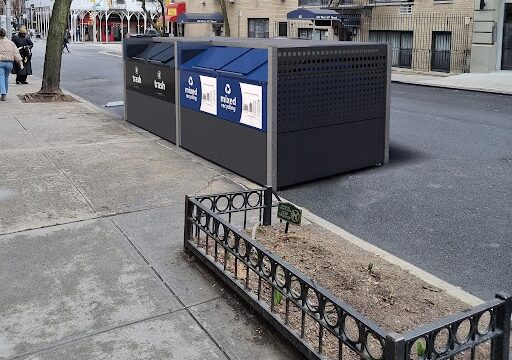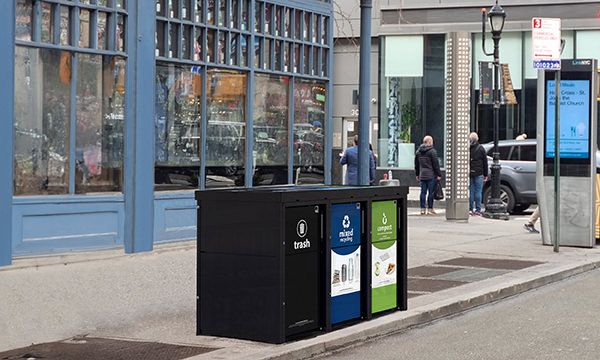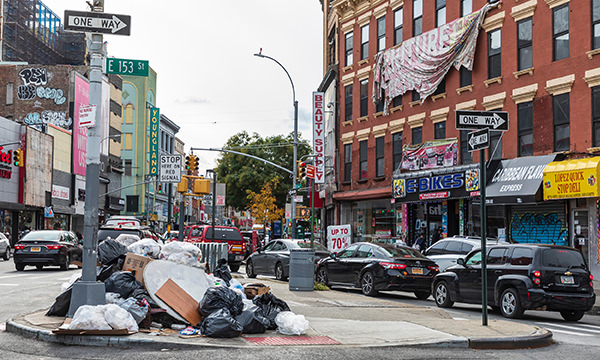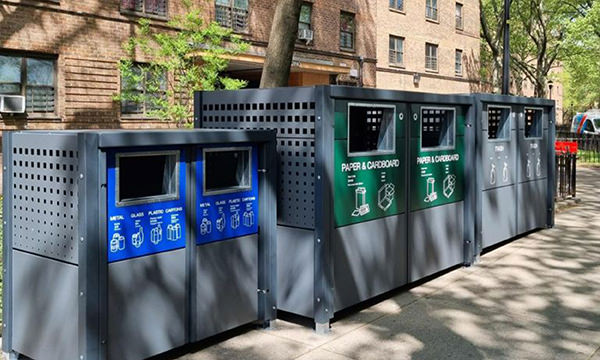

Increasing Capture of Trash & Recyclables Using On-street Garbage Enclosures
Trash-covered streets and a lack of access to recycling in public areas can create a multitude of issues, from an unsightly visual appearance and the encouragement of crime and antisocial behavior, to health and wellbeing issues for homes, businesses and the general public, as well as acting as hindrances towards achieving high capture rates and waste diversion targets.
Changing behaviors towards this issue and waste management as a whole comes down to appropriate education to raise awareness of correct practice, combined with easily accessible infrastructure.
The EPA, which began collecting and reporting data on waste generation in the United States more than 35 years ago, published the following facts and figures (current through the calendar year 2018) as part of ongoing efforts to measure the success of materials management programs across the country.
For 2018, the total generation of municipal solid waste (MSW) was 292.4 m tons. Approximately 69m tons of this was recycled, with 25m tons composted. Combined, this was equivalent to around a 32% recycling and composting rate. The EPA categorizes MSW as various items that consumers dispose of after use, such as bottles, food, yard trimmings, bulky waste, and some electrical items, but does not consider items that could be landfilled at a local level, such as construction and demolition debris, and other non-hazardous industrial wastes. Plastic, in particular, continues to pose significant problems amongst MSW. According to research compiled in a report by Greenpeace, only 5% of plastic waste generated by US households in 2021 was recycled. Americans discarded about 309lb of plastic per person in 2021, of which almost 95% ended up in landfills.

MSW management continues to be a high priority for municipalities at both state and local government level. While efforts are being made to encourage reduction of waste at the source level, as well as the recovery and conversion of generated waste for recycling, composting, and energy, increasing the capture of trash and recyclables represents an ongoing challenge. Low capture rates are often not a result of consumerism or laziness from households, but rather a lack of education and access to effective waste management infrastructure.
Managing trash and properly separating recyclables, specifically in multifamily buildings, presents distinct challenges. These environments often contain individuals with competing priorities and differing attitudes towards waste management. Combined with a lack of individual householder accountability, this can create problems, particularly if access to gated communal deposit points is hindered by collections of loose trash bags. It’s also worth noting that most dumpster lids exceed the requirements contained within the Americans with Disabilities Act of 1990 (ADA). A proportion of residents experience great difficulty lifting a heavy dumpster lid with one hand to drop their trash in with the other. Side waste can then occur, perpetuating the access issues and leading to illegal dumping.

In more densely populated neighborhoods, overriding demands for car parking and vehicle unloading space mean that residents and businesses are often deprived of enough on-street space to store their trash and recyclables as they await collection. While many cities are looking to introduce by-laws which prohibit bagged trash from being placed curbside for collection, the solution to distribute multiple roll-out carts could potentially create more problems in of itself, such as obstructions, increased fire risk, and a level of undesirable visual impact.
Due to the widespread diversity of language and cultures across the US communities, low capture rates and the barriers to recycling are often derived from a lack of access to clear and concise visual guidance about how to recycle properly. While this aspect means there are no one-size-fits-all solutions, an awareness of equitable outreach is key to achieving higher waste & recycling capture on the streets.
Recycling terminology has the potential to be complex in any language, but the lack of clarity that exists around recycling and ineffective information creates barriers that over complicate what can be a very simple system. Effective, far-reaching operations are entirely possible if all residents among communities are provided with clear, multilingual communication at waste & recycling disposal points. Investment in effective infrastructure is key to changing behaviors towards waste management, enabling users to feel confident in their ability to correctly recycle.
To increase the capture of trash & recyclables, metroSTOR has developed a series of on-street enclosures, housing carts & dumpsters individually to optimize storage capacity to provide the appropriate quantity and type of recycling bins in accessible locations for every household, and encourage correct recycling practice within a given, compact footprint.

Securing containers within on-street enclosures with restricted apertures enables users to place items directly into the correct container without getting their hands dirty, a key approach to removing much of the motivation behind side waste accumulation, in addition to reducing opportunities for bulk deposits.
The ability to integrate access control systems is of benefit to both waste generators and collection personnel, preventing antisocial behavior and unauthorized usage, while the visually appealing facade of the series helps to reduce visual impact on the streetscene. This is supported by clear communication as to which materials go in each container, alongside the use of graphics with simple color-coding and symbols as opposed to masses of text, making it as easy as possible for users to engage with the facility correctly.
As part of considerable efforts to improve the city’s waste management system and improve the overall street scene, New York is in the midst of a major shift toward city-wide waste containerization. The latest DSNY pilot project is a $5.6m initiative that will see wheeled containers deployed across 10 high-density residential blocks and 14 public school buildings. Following the roll-out of the pilot in Manhattan’s West Harlem area in August this year, the city is now advancing multiple projects to work towards containerizing waste on 89% of streets, following on from the agency’s ‘The Future of Trash’ report published in May this year.

The existing system utilized by the DSNY includes streams covering general refuse and recyclables, including metal, glass and plastic, and a paper and cardboard stream, as well as impending plans to integrate organics. Due to a general lack of service alleyways in the city’s infrastructure, much of the agency’s collection services are made curbside through a combination of front-load collections and roll-off collection at schools, institutions and public housing locations.
Encompassed in the overall shift by the city is the ‘Clean Curbs for All’ Pilot, which has seen metroSTOR working with the New York City Housing Authority (NYCHA) providing on-street enclosures as 1 pilot option in designated on-street housing areas, in order to help better-manage residential waste material. This is in addition to the placing of steel enclosures by the DSNY on city streets in the parking lane. This has taken place across all 5 boroughs in both commercial and residential locations, and has already led to an overall net improvement for the containerized areas.
Looking towards the city’s overall shift, the report found that individual bins can be an effective solution for low-density areas in the 5 boroughs, with the potential for larger on-street enclosures to be collected in the same manner. This is a common solution in cities where multifamily collection is managed separately. With regard to the remaining 11% of streets that DSNY says are unfeasible for this system; mainly high-density areas which account for an estimated 23% of residential waste in the city, one proposed solution is the use of high-density compactors, with materials transferred into wheeled containers that would then be placed curbside temporarily to await collection.
Ultimately, the diversity of urban communities across many cities in the United States, as well as the varying density of households, means that providing effective waste management infrastructure for households and public areas presents a complex challenge. What is clear, however, is that a lack of consistent access can lead to capture rates that are suboptimal, with the root cause of the issue often lying in a lack of education and access to effective infrastructure.
Investing in on-street containerization and garbage enclosures can provide a crucial step towards both increasing capture and enhancing waste management as a whole; optimizing storage capacity, reducing the visual impact of loose bins, and helping to encourage correct recycling practices.
By deploying containers in a high-density city, New York’s Clean Curbs Pilot Project aims to address the waste-management challenges posed by its unique infrastructure. An aspect of this scheme involves enclosing on-street carts and dumpsters as part of efforts to improve the city’s overall streetscene and increase capture rates, providing an important shift towards waste-diversion targets and enabling more efficient collection methods.



